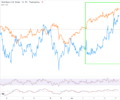
- US dollar at 2-month peak on US GDP beat, doubts about aggressive Fed easing cycle
- Cautious start to big week for central banks and US-China trade talks
- Pound tumbles to 28-month low as new UK PM sets ground for no-deal Brexit

Dollar holds firm ahead of Fed
The US dollar held onto Friday’s gains at the start of the trading week following the boost from better-than-expected US growth figures for the second quarter. The American economy grew by an annualized 2.1% in Q1, above forecasts of 1.8% and casting doubt about the prospect of significant easing by the Federal Reserve, which is due to meet this week for a rate setting decision.
Further lifting the greenback on Friday were remarks by the White House’s chief economic advisor, Larry Kudlow, who told reporters that President Trump had ruled out intervening in the currency markets to weaken the dollar.
The dollar index was trading close to Friday’s two-month top of 98.09, while against the yen, the greenback hovered around 108.60. Whether the US currency will be able to stay on the front foot will very much depend on what the Fed signals on Wednesday when it is expected to cut interest rates for the first time since the financial crisis.
Prior to the GDP data, investors had fully priced in rate cuts of up to 100 basis points over the next 12 months. But those odds have fallen slightly as the Q2 growth numbers were the latest in a series of solid economic indicators to come out of the United States. While the consensus among market participants remains that the Fed will embark on a full-on easing cycle, any hints by Fed Chairman Jerome Powell on Wednesday that the expected cut is merely an ‘insurance’ move, could lead to a much more significant unwinding of the aggressive rate cut bets.
Busy week as BoJ and BoE meet too, new round of US-China trade talks
Ahead of the Fed, the Bank of Japan will announce its latest decision on Tuesday and could flag additional stimulus if conditions deteriorate further. However, the BoJ is unlikely to make any changes to its policy this week and so the yen stands to gain versus its US counterpart as long as the BoJ does not surprise and the Fed does not disappoint.
Also crucial for both the yen and the dollar, as well as for broader risk sentiment will be tomorrow’s planned talks between US and Chinese trade negotiators. The meeting in Shanghai will be the first face-to-face one between the two sides and investors will be looking for signs that the US and China are able to bridge their differences following the sharp escalation in May that led to the breakdown of negotiations.
However, comments from President Trump have so far not been very encouraging. Trump suggested on Friday that China could delay signing a trade agreement until after the 2020 presidential election in the hope that they might be able to get a better deal if a Democrat was to get elected as president.
Sterling crashes as Johnson raises no-deal Brexit risk
New British prime minister, Boris Johnson, appeared to be preparing the country for a disorderly exit from the European Union after he told EU leaders that there will be no negotiations unless the Irish border backstop is abolished. This sets Johnson on a possible collision course with the EU, who branded his demands as “unacceptable”. Some think the PM could also be laying the groundwork for a snap general election as polls suggest the Conservatives’ popularity has surged following Johnson’s win in the party leadership contest.
The pound hit a fresh 28-month low of 1.2333 as traders priced in an increased probability that the UK would leave the EU without a deal on October 31. The British currency is at risk of coming under additional downside pressure if the Bank of England drops its tightening bias as expected and adopts a more dovish tone at its policy meeting on Thursday.
Other majors didn’t fare much better on Monday as the euro was stuck near two-year lows on expectations that the European Central Bank will ease policy in September, while the Australian dollar struggled at two-month lows in anticipation of further rate cuts by the RBA in the coming months.




 SP500
SP500 FTSE
FTSE FCE
FCE Nasdaq100
Nasdaq100 Russell2000
Russell2000 Index Nikkei225
Index Nikkei225 DOW 30 (DJI)
DOW 30 (DJI) RTS futures
RTS futures RTSI
RTSI DAX30
DAX30 eBay Inc.
eBay Inc. Google Inc.
Google Inc. IBM Corp.
IBM Corp. Microsoft
Microsoft  Apple
Apple Yandex
Yandex Toyota
Toyota Volkswagen
Volkswagen Facebook
Facebook Tesla
Tesla Twitter
Twitter Hasbro
Hasbro Bitcoin
Bitcoin Litecoin
Litecoin BitcoinCash
BitcoinCash Dash
Dash Ripple
Ripple Ethereum
Ethereum EmerCoin
EmerCoin NameCoin
NameCoin PeerCoin
PeerCoin Monero
Monero ETC/USD
ETC/USD Silver
Silver Platinum
Platinum Palladium
Palladium Copper
Copper Gold
Gold